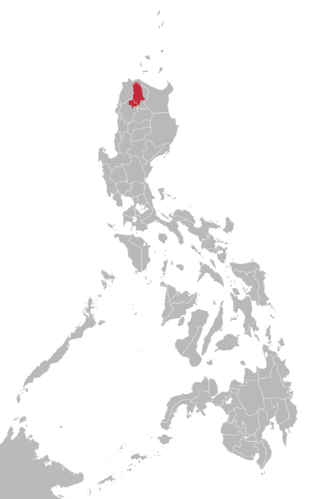| Isnag | |
|---|---|
| Isneg | |
| Native to | Philippines |
| Region | most parts of Apayao province, northern parts of Abra, Luzon |
Native speakers | (30,000–40,000 cited 1994)[1] |
| Language codes | |
| ISO 639-3 | Either:isd – Isnagtiu – Adasen Itneg |
| Glottolog | isna1241 Isnagadas1235 Adasen |
| ELP | Adasen Itneg |
| Linguasphere | 31-CCA-a incl. inner units 31-CCA-aa...-ae |
 Area where Isnag (including Adasen Isneg) is spoken according to Ethnologue | |
Isnag (also called Isneg) is a language spoken by around 40,000 Isnag people of Apayao Province in the Cordillera Administrative Region in the northern Philippines. Around 85% of Isnag are capable of reading the Isnag language.[citation needed] Many Isnag speakers also speak Ilocano.
Dialects[edit]
Ethnologue lists the following dialects of Isnag.
- Bayag
- Dibagat-Kabugao
- Calanasan
- Karagawan (Daragawan)
- Talifugu-Ripang (Tawini)
Alternate names for Isnag include Apayao, Dibagat-Kabugao-Isneg, Isneg, and Maragat (Ethnologue).
Isnag is spoken in the northern two thirds of Apayao Province, Cagayan Province (Claveria and Santa Praxedes municipalities), Abra, and Ilocos Norte Province, and scattered areas along the Apayao western border (Ethnologue).
The closely related Adasen (Addasen, Addasen Tinguian, Itneg Adasen) language, which consists of western and eastern dialects, is spoken in northeastern Abra and into western Apayao Province. There are 4,000 speakers (Ethnologue).
Sounds[edit]
| Front | Back | |
|---|---|---|
| High | i | |
| Mid | e | o |
| Close | a | |
| Labial | Alveolar | Palatal | Velar | Glottal | ||
|---|---|---|---|---|---|---|
| Nasal | m | n | ɲ | ŋ | ||
| Plosive/ Affricate |
voiceless | p | t | tʃ | k | ʔ |
| voiced | b | d | dʒ | ɡ | ||
| Fricative | f v | s ʃ | h | |||
| Approximant | l | j | w | |||
| Tap | ɾ | |||||
Isnag is one of the Philippine languages that do not exhibit [ɾ]-[d] allophony.[citation needed]
Language sample[edit]
- Isnag: Mahi indo' tada ngamin ta ngamin tada ay magwawwáhi, ta ya pahin indo' kiya isa tulay ay maggayát ke Dios. – 1 Juan 4:7
- Isnag: Day-dayáwan tada nge Dios, nga Dios se Ama naya Apu tada nga Jesu-Cristo. – 1 Pedro 1:3
- Approximate English Translation: Praise God, the God and Father of the Lord Jesus Christ. – 1 Peter 1:3
Historical sound changes[edit]
The Proto-Malayo-Polynesian schwa ə has merged to /a/ such as *qatəp > atap ('roof') similar to Kapampangan, atip in Tagalog and atup in Visayan.[2]
References[edit]
- ^ Isnag at Ethnologue (18th ed., 2015) (subscription required)
Adasen Itneg at Ethnologue (18th ed., 2015) (subscription required) - ^ "Word: Thatch/Roof". Austronesian Basic Vocabulary Database. Archived from the original on 2017-04-25. Retrieved 2009-11-26.